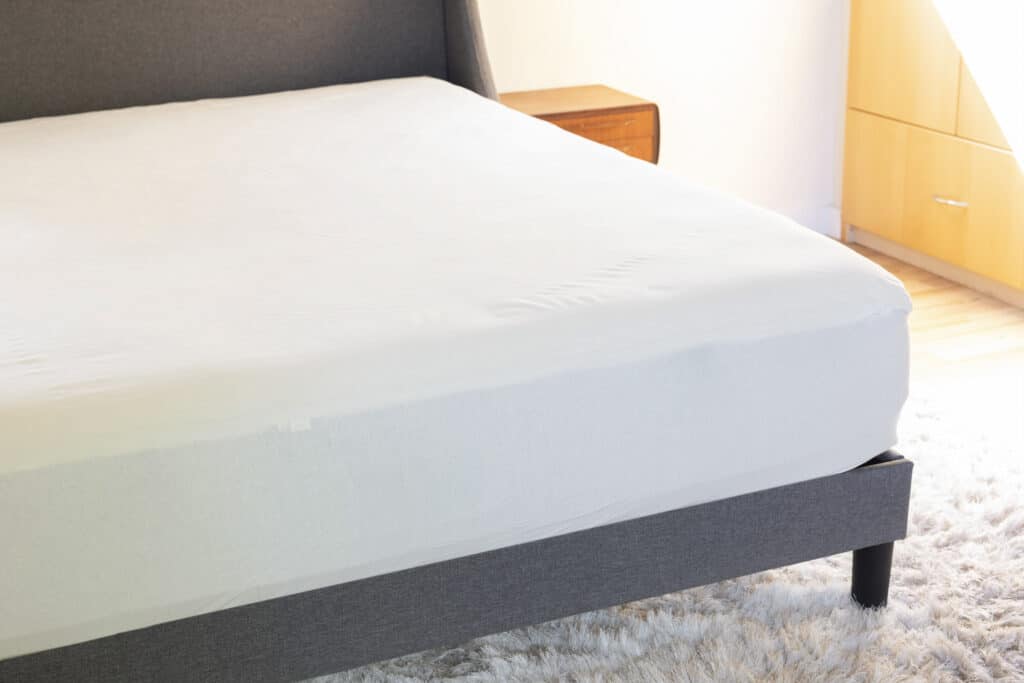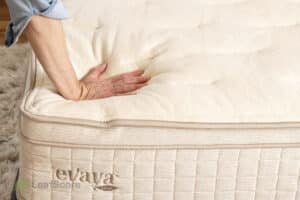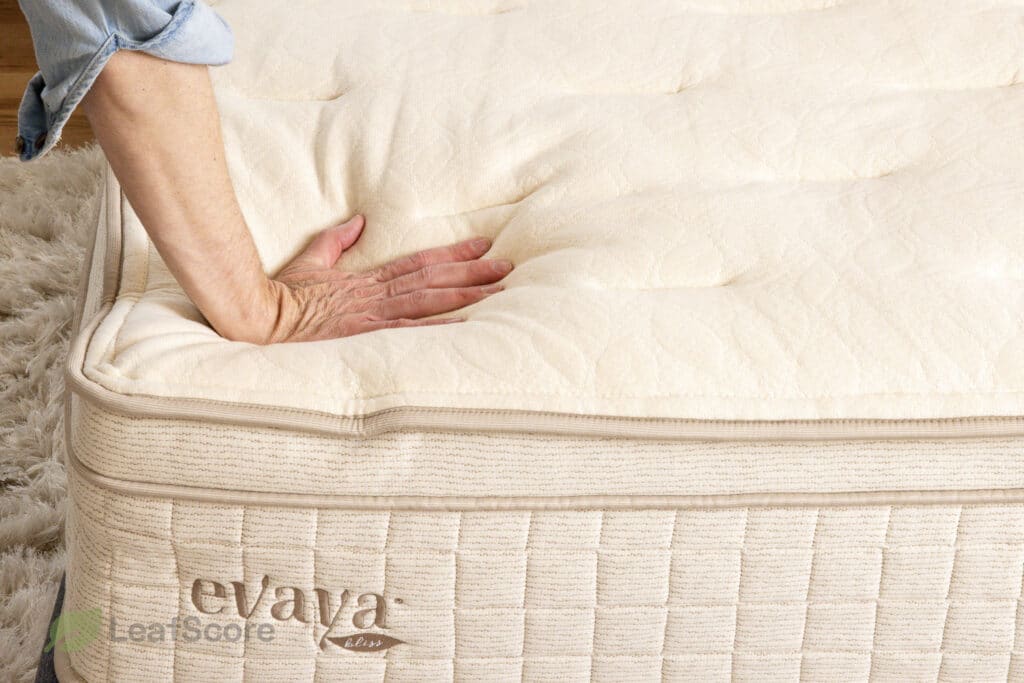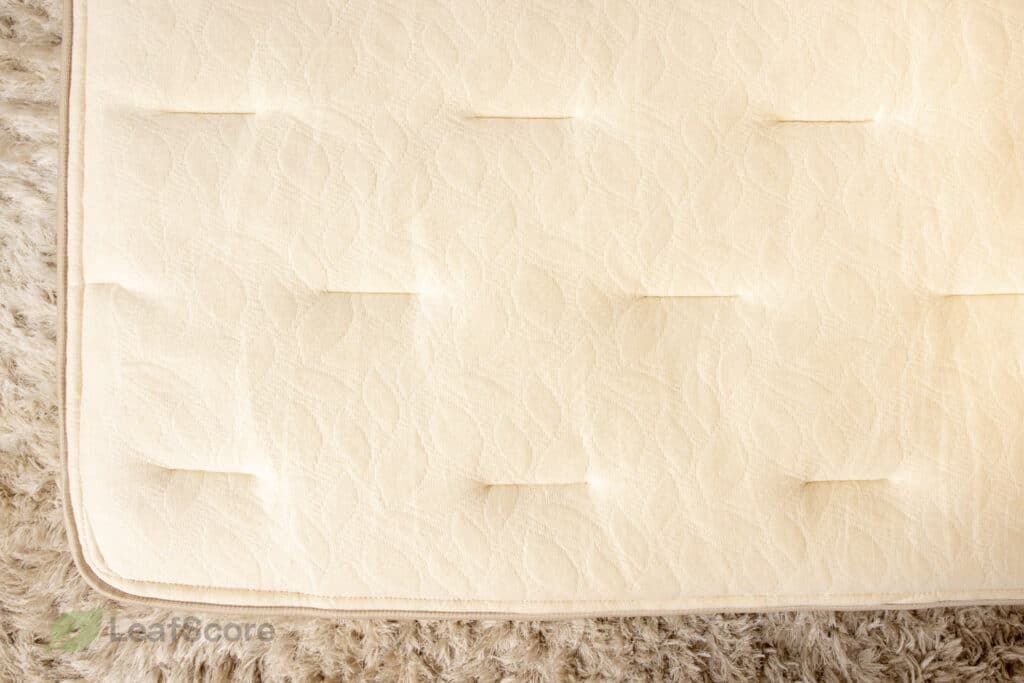Our complete guide to toxic chemicals in mattresses shines a light on what to avoid when buying a new mattress and the downsides of modern mattresses for people and planet.

Table of Contents
Mattress industry leader, Walter Bader, was so concerned by the toxic slew of chemicals used in mattress manufacture that he sent several mattresses to an Atlanta-based lab for testing. One memory foam model was found to emit 61 volatile organic compounds (VOCs), including known carcinogens benzene and naphthalene!
In his book, Sleep Safe in a Toxic World, Bader compared the lack of regulations around mattresses to that of cigarettes in the 1930s:
‘Completely unregulated and everyone thinks they’re safe.”
Sleep Safe in a Toxic World
Note: If you want to know what’s in your mattress, you can send foam samples to Duke University for a toxicity analysis through their Foam Project.
What’s in a mattress?
Most modern mattresses are made with:
- Polyurethane foam
- Synthetic latex
- Conventional cotton
- An astonishing amount of glue, flame retardants, and other chemicals.
All of these pose problems for human health and the environment.
Polyurethane foam
The North America polyurethane market is dominated by four chemical giants:
- BASF
- Bayer Material Science
- The Dow Chemical Company
- Huntsman Corporation.
Together, these companies account for more than 75 percent of total production.
Personally, I’d rather not give these huge corporations my money, especially given their track records for transparency around the safety of their products and processes.
Also known as “polyfoam”, polyurethane foam has been the standard fill for many mattresses since the 1960s. It is mass-produced, cheap, and easy to compress, giving rise in recent years to the direct-to-consumer bed-in-a-box phenomenon. Sure, these mattresses are cheaper to produce and ship and reduce energy expenditure associated with transportation, but they only last a few years at best and are an environmental nightmare.
See also: Why we don’t recommend Certipur mattresses
| Made from non-renewable fossil fuels | Many toxic chemical inputs | Offers poor support over time |
| Off-gases hazardous VOCs | Hard or impossible to recycle | Traps heat and sweat |
| Breaks down fast / isn’t durable | Not biodegradable | Can cause back and neck pain |
| Gets lumpy and uncomfortable | Not responsive / terrible for sex! | Beloved by bed bugs, mold, and mildew |
Polyfoam mattresses pose several safety issues. Even the beleaguered US Environmental Protection Agency (EPA) – whose inspections fell to an all-time low under the Trump presidency – has issues with the chemicals used in polyurethane manufacture.
Here are some of my biggest beefs with polyurethane foam mattresses.
Polyfoam is energy-intensive
First, polyurethane foam is produced through the same energy-hungry process used to make petroleum from crude oil.
This process involves two main ingredients: polyols and diisocyanates, which are reacted together using a variety of catalysts, including dibutylin (DBT, more on this below).
Check out the Evaya Bliss, a Made Safe and Eco-Institut Mattress we started carrying in our online store, LeafScore Essentials. Evaya’s certifications guarantee the product is free of even trace amounts of harmful chemicals. Use code ESSENTIALEVAYA for 15% off your order.
Polyfoam is made with known carcinogens
Polyols themselves are substances created through a chemical reaction using propylene oxide (methyloxirane). As for diisocyanates, toluene diisocyanate (TDI) is the most common isocyanate involved in the manufacture of polyurethane.
Both methyloxirane and TDI are recognized as carcinogens by the State of California and the U.S. Centers for Disease Control. They’re known to cause tumors (mostly mammary and brain tumors for methyloxirane and TDI respectively). Both are included on the List of Toxic Substances under the Canadian Environmental Protection Act, and “Studies in animals have demonstrated that propylene oxide is a direct-acting carcinogen” (R).
Polyfoam production causes air pollution
The U.S. EPA considers manufacturing plants producing polyurethane foam to be major sources of myriad hazardous air pollutants. Such pollutants include:
- Methylene chloride
- Toluene diisocyanate (TDI) itself
- Hydrogen cyanide.
Part of being a conscious consumer is understanding the impact of our choices on those producing the things we buy. This is driven home by the numerous cases of occupational exposure in factories to the chemicals just mentioned. According to the CDC, such exposure can result in isocyanate-induced:
- Asthma
- Respiratory disease
- Death.
While safety has improved greatly in U.S. factories in recent years, there remains the potential for health problems related to accidental exposure to high levels of TDI as well as to cumulative exposure.
We also need to consider the wellbeing of those living close to manufacturing plants, who often have limited income and little opportunity to move away. Again, this is highlighted by a case where the State of North Carolina forced the closure of a polyurethane manufacturing plant because tests revealed that local residents were being exposed to potentially dangerous levels of TDI.
Polyfoam, off-gassing, and household dust
The United States Occupational Safety and Health Administration (OSHA) has not established exposure limits on carcinogenicity for polyurethane foam from end-use products. This is largely due to a lack of data. It does not mean polyfoam in mattresses, couches, carpet underlay and other common household products aren’t a cause of hazardous air pollutants.
As with all chemicals, it’s the dose that makes the poison, and it’s especially difficult to quantify cumulative exposure to VOCs and other chemicals from all of the polyfoam products we come into contact with each day. It’s also difficult, if not impossible, to attribute specific health conditions to chronic exposure to chemicals found in mattresses.
Instead, we can turn to laboratory studies investigating the health effects of short-term exposure to chemicals commonly found in polyfoam, including:
- Toluene (a known neurotoxin)
- Benzene and propylene oxide (known carcinogens)
- Styrene, antimony, formaldehyde (also carcinogens and neurotoxins)
- Dibutylin (a source of organotins, which cause growth abnormalities in mussels and oysters and mass mortality in marine mammals).
Dibutylin (a catalyst used in polyfoam manufacture) can cross the placenta in mammals and accumulate in the brain, where it acts as a potent neurotoxin, killing brain cells.
Organotins in general have been linked to disruption of:
- Behavioral functions
- Neurotransmitters
- Neuroendocrine pathways.
Even after its initial potent off-gassing, polyfoam continues to break down and create toxic household dust. The industry claims that polyfoam is durable, but these mattresses can lose half their original weight in just a few years. This is of particular concern in households with young children and pets, who tend to spend more time exposed to dust on floors and furniture.
Polyfoam mattresses, mold, mildew, and bed bugs
Polyfoam mattresses are typically very porous but not very breathable, meaning that they can accumulate moisture and tend to harbor mold and mildew. They can also make for a pleasant, dusty and damp home for bed bugs.
Flame retardants and other VOCs in mattresses
Have you ever wondered what creates that fresh mattress smell?
That’s the lovely aroma of volatile organic compounds (VOCs), which can include a heady mix of flame retardants and other chemicals. VOCs, many of which are classed as carcinogens, are emitted as a breathable gas from:
- Mattresses
- Carpets
- Couches
- Soft furnishings
- Paint
- Cleaning supplies
- Printer ink.
Some VOC’s are also greenhouse gases, meaning that they contribute to climate change. And, as we know, climate change has its own negative effects on health, such as increasing air pollution from wildfires, and causing soil erosion, drought, flooding, increasingly deadly tornadoes and so forth.
Concentrations of VOCs can be ten-fold higher inside the house than outdoors. If you’re interested in tracking VOCs in your home, we highly recommend this air quality monitor.
Polyfoam mattresses typically contain a slew of VOCs. Even though manufacturers claim that the polyols and isocyanates in polyfoam have reacted and are no longer volatile, this isn’t quite true. The reaction that creates polyurethane results in pockets of trapped unreacted chemicals, which may be released as the mattress material degrades.
How VOCs affect health
VOCs have been linked to a variety of health concerns, including:
- Headaches
- Nausea
- Dizziness
- Nasal irritation
- Allergic reactions
- Neurological problems
- Liver and kidney damage
- Cancer
- Fertility problems
- Miscarriage.
Polyfoam mattresses often off-gas VOCs from chemicals used as:
- Stain and water repellents
- Antimicrobial treatments (which are necessary for porous polyurethane foam)
- Adhesives
- Flame retardants.
Firefighters often refer to polyfoam as ‘solid gasoline’ because it is highly flammable. To meet federal fire safety regulations, most mattress makers douse the polyfoam in toxic chemical flame retardants.
Common chemical flame retardants in mattresses
PBDE flame retardants used to be very common in North America and are especially toxic and persistent (see the FAQs below). These chemicals have mostly been replaced by halogenated flame retardants, which come with their own risks.
Bromine, chlorine, fluorine, and iodine are elements known as halogens. Halogenated flame retardants (HFRs) act directly on flames, interfering with the chemistry of the flame to prevent fire. Chlorine and bromine are both used as flame retardants, with brominated retardants the most effective.
HFRs have been linked to a raft of health concerns, including (R):
- Abnormal reproductive development and delayed puberty
- Neurobehavioral changes, damage to brain and nerve function
- Thyroid disruption
- Cancer.
Antimony and Boric Acid are two other flame retardants commonly used in mattresses. Antimony is a toxic heavy metal which can cause eye, heart, and lung problems. Boric Acid can cause eye and respiratory irritation.
Why care about flame retardants in mattresses?
Flame retardants are commonly found in household dust. And, because many HFRs are persistent and bioaccumulative, they are increasingly present in human blood and breast milk. HFRs also accumulate in wild animals, with widespread environmental contamination and the highest concentrations in the Arctic and marine mammals (R). Smarter mattress design and materials such as hemp, wool, and flax offer alternatives to chemical flame retardants.
In one article, Arlene Blum, a biophysical chemist and visiting scholar at the University of California, Berkeley, suggested that:
Instead of adding new fire retardant chemicals that ultimately may be shown to cause health problems, we should be asking whether we need to use these chemicals or if there are other ways to achieve equivalent fire safety.
Arlene Blum, biophysical Chemist
Novel flame retardants
Some companies are investigating novel strategies to make mattresses fire-resistant, such as using nanomaterials to coat fibers. Unfortunately, there is limited safety data on nanoparticles. Worryingly, some of the chemicals used to disperse nanoparticles in treated fibers may themselves be toxic (R).
Researchers have also begun looking at tartaric acid derivatives as natural flame retardants (R). This looks promising as an eco-friendly treatment and is produced in large quantities in the normal course of making wine.
Synthetic latex
Polyurethane isn’t the only problematic material in mattresses. While natural latex is an excellent eco-friendly and safe material from which to make mattresses, many ‘latex’ mattresses are actually made with synthetic latex. This is also a synthetic petroleum product chock-full of toxic chemicals that off-gas VOCs.
Don’t get greenwashed. Check that the latex in your mattress of choice is actually natural latex.
How is synthetic latex made?
Synthetic latex is made using styrene and butadiene, two petroleum-based products and VOCs. This is why synthetic latex is often called styrene-butadiene rubber (SBR). When SBR is mixed with 100 percent natural latex, some manufacturers disingenuously refer to the final product as natural latex. Natural latex may also be used to describe a combination of polyurethane and 100 percent natural latex.
Look, then, for products that specifically state that they are made with 100 percent natural latex and no synthetic latex. Mattresses with Global Organic Latex Standard (GOLS), EcoInstitut, or MadeSafe certification should only contain natural latex.
What’s the problem with SBR (synthetic latex)?
There are several issues with SBR or synthetic latex. On the environmental side, synthetic latex is:
- An unsustainable petroleum product
- Not biodegradable, nor durable
- Not recyclable.
On the health side, SBR is problematic because it is:
- Made with a slew of synthetic additives (many of which are themselves toxic)
- Not resistant to mold, mildew, or dust mites (100 percent natural latex is somewhat resistant)
- Not fire-resistant, so must be treated with flame retardants (typically toxic chemicals)
- Toxic to the lungs, liver, and brain and may increase the risk of leukemia and lymphoma (R)
- Made with butadiene, which is harmful to the nervous system, may be carcinogenic, and irritates eyes and skin (R).
Vinyl in mattresses
Finally, some mattresses, especially crib mattresses, have a waterproof and antibacterial cover. Typically, this is made with vinyl, a material made using toxic chemicals and additives associated with serious health concerns. As vinyl is exposed to heat, moisture, and air (as in normal mattress use), it breaks down and leaches chemicals.
Some of the chemicals in vinyl include phthalates and heavy metals like antimony. These can adversely affect:
- Reproductive health
- Fetal development (R)
- Asthma and allergies (R)
- Childhood development and behavior (R).
Vinyl production also releases dioxins, which I’ve written about many times at Leaf Score as these chemicals can cause:
- Cancer
- Birth defects,
- Changes in neurological development.
Unfortunately, vinyl is most commonly found in crib and children’s mattresses. In fact, even many ‘natural’ crib mattresses have a synthetic latex or vinyl, urethane, 4-phenylcylclohexene, or polyvinyl chloride (PVC) cover. Manufacturers are not legally required to list vinyl on labels, so be sure to ask if it is present when buying any new mattress.
The best non-toxic, organic mattress brands
Remember Walter Bader who compared mattresses to cigarettes? He went on to found Organic Mattresses Inc. (OMI), a company making mattresses by hand from cruelty-free wool, certified organic cotton, and 100 percent natural rubber latex in a facility where no one is allowed to smoke, wear fragrances, or even use fabric softeners.
As our featured brand in our online store, we started carrying the Evaya Bliss at a discounted rate for readers. Evaya is both Eco-Institut and Made Safe Certified.

Evaya Organic Mattress [Staff Tested]
Eco-Institut and Made Safe Certified, will never off-gas, and certified to be free of even trace amounts of hazardous chemicals. Manufactured using EverEden Premium wool sourced from New Zealand farmers.
Use code ESSENTIALEVAYA for 15% off the Evaya Bliss in the LeafScore store.
Want to learn more about safe, sustainable sleep? Check out the Leaf Score Guide to Organic, Non-Toxic Mattresses.
FAQs
The one good thing you can say about polyfoam is that, technically, it can be recycled. That is, pre-consumer manufacturing scraps can be turned into things like carpet backing.
Don’t let manufacturers greenwash this, though: end user products, such as mattresses, are very difficult to recycle and mostly end up in landfill where they break down and release toxic chemicals into the ground, air, and water.
Blame California!
Ironically, the state that now seems intent on leading the way in terms of eco-friendly regulations is the one we can blame for toxic flame retardants in mattresses.
In 1975, the State of California passed legislation (TB117) requiring manufacturers to treat mattresses and furniture to make them safe from cigarettes that could smolder and start a fire. This legislation did not, however, offer guidance as to how to make these products safe.
In response, manufacturers began dousing everything in Polybrominated Diphenyl Ethers (PDBEs). So as not to have to create two sets of mattresses for sale nationwide, mattress manufactures chose to use the California’s standard in all their mattresses.
In 2014, California updated TB117 to enable manufacturers to transition from the open flame test process mandated in 1975 to new methods for smolder resistance. This revision makes it easier for manufacturers to meet the requirements without toxic chemicals. However, as it does not explicitly call for the elimination of flame retardants such as PDBEs, many manufacturers continue to use these dangerous chemicals in their products.
Researchers continued to find PDBEs in the majority of dust samples collected from homes in California in 2015.
Even though PBDEs have mostly now been banned, levels of PBDE in North Americans remain higher than those in Europe and Asia where the chemicals were less widely used. What’s more, the body burden of PBDEs is three- to nine-fold higher in infants and toddlers than in adults (R). This is likely because of exposure to maternal milk and dust.
The most common PBDE isomers found in humans are Tetra-, Penta-, and Hexa-BDEs. PBDEs have a long half-life, meaning that they persist in the environment. Studies suggest that these chemicals may cause (R, R):
Disruption to thyroid function
Neurodevelopmental deficits and long-lasting behavioral and motor activity anomalies
An increased risk of cancer.
While some fire retardant chemicals have been banned, other potentially problematic chemicals continue to be used in children’s products. These include Firemaster 550, a toxic cocktail of chemicals including phthalates.
Children’s mattresses and crib mattresses are also commonly treated to make them waterproof. It’s a tragic irony, then, that infants and children are also more vulnerable to the negative effects of the chemicals used in waterproof covers, such as the phthalates found in vinyl. Indeed, a law was passed in 2009 in the U.S. House of Congress forbidding the use of three types of phthalates often found in mattresses.
If, after everything above, you still plan to purchase a polyfoam mattress, here are some questions you’ll want to ask.
1. Where does the company source its polyfoam?
Polyfoam made in the U.S. or EU is subject to stricter safety regulations than foam made in many other regions and countries.
2. How dense is the foam?
Foam can range from around 2.5 lb. to more than 5.5 lb. per cubic foot. Foam under around 3 lb. is considered low density and can feel soft while still being comfortable. The other benefit of lower-density foam is that it contains lower amounts of polymers and, thus, uses fewer resources and has less to off-gas.
3. How does the mattress meet safety requirements for flammability?
If a product is coated in chemical fire retardants, avoid it. Look instead for one that has an outer cover made with something like Rayon, silica and Kevlar (check that this doesn’t just apply to mattress seams). These materials are not eco-friendly, but they can help reduce the amount of chemicals that need to be applied for a mattress to meet fire safety standards.
Genuinely natural latex is much safer and more eco-friendly than synthetic latex or memory foam but is more costly to produce. It requires the cultivation of Hevea-Brasiliensis rees and processing of the rubber tree sap. This is much more time-consuming than creating petroleum-based synthetic latex in a chemical plant.
Expect, then, to pay a little more for latex that is 100 percent natural. Remember, though, that natural latex mattresses typically last far longer than synthetic mattresses, so the cost evens out over time and a natural mattress may actually cost less long-term.
It’s also worth noting that the true cost of natural latex is far lower than SBR when you factor in your health, your family’s health, worker health, and the wider environment.
If you lived in Canada and bought a polyurethane foam mattress or other foam product between 1999 and 2012, you may have been overcharged (in an illegal way).
A Canadian court ruled that polyfoam manufacturers formed a price-fixing cartel, forcing consumers to overpay for polyfoam products. Consumers were given the opportunity to file claims for compensation and get cash back from the 38 million (Canadian) dollar settlement. If you didn’t file a claim, you’ve missed out. The compensation period is now closed.
However, you can still read all about Canada’s biggest ever price-fixing scandal here!
If a company claims that its mattresses are VOC-free, make sure this is not just marketing hype. Mattress companies have been fined over and over again for making false claims over VOCs. The Federal Trade Commission sued and fined the following companies for claiming that their products were VOC-free without supportive evidence:
Essentia
Relief-Mart/Temp-Flow
Ecobaby Organics.
In Europe, pan-European Union legislation such as REACH and RoHS, as well as the Stockholm Convention (to which the USA is not a signatory) effectively mean that the use of brominated fire retardants is being phased out for good. In the U.S., however, bans on the use of HFRs vary from state to state.

